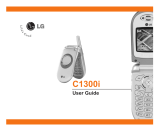
Guidelines for safe and efficient use
6
Guidelines for safe and efficient use
for this model phone when tested for use at the ear
is 0.917 W/kg and when worn on the body, as
described in this user’s manual, is 0.059 W/kg.
(Body-worn measurements differ amongphone
models, depending upon available accessories and
FCC requirements.) While there may be differences
between SAR levels of various phones and at various
positions, they all meet the government requirement
for safe exposure.
Product care and maintenance
Warning! Only use batteries, chargers and
accessories approved for use with this particular
phone model. The use of any other types may
invalidate any approval or warranty applying to the
phone, and may be dangerous.
]
Do not disassemble this unit. Take it to a qualified
service technician when repair work is required.
]
Keep away from electrical appliances such as a TV's,
radios or personal computers.
]
The unit should be kept away from heat sources
such as radiators or cookers.
]
Never place your phone in a microwave oven as it
will cause battery to explode.
]
Do not drop.
]
Do not subject this unit to mechanical vibration or
shock.
]
The coating of the phone may be damaged if
covered with wrap or vinyl wrapper.
]
Do not use harsh chemicals (such as alcohol,
benzene, thinners, etc.) or detergents to clean your
phone. There is a risk of this causing a fire.
]
Do not subject this unit to excessive smoke or dust.
]
Do not keep the phone next to credit cards or
transport tickets; it can affect the information on
the magnetic strips.
]
Do not tap the screen with a sharp object as it may
damage the phone.
]
Do not expose the phone to liquid or moisture.
]
Use accessories, such as earphones and headsets,
with caution. Ensure that cables are tucked away
safely and do not touch the antenna unnecessarily.
]
Please remove the data cable before powering on
the handset.
KG220 AUS(Optus)_0523 2006.5.24 1:58 PM Page 6






















